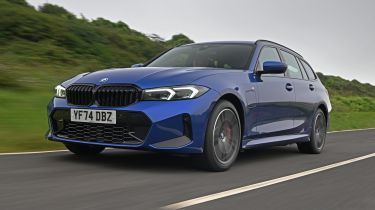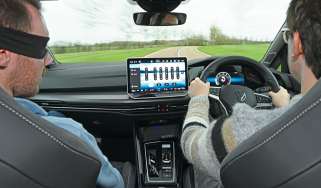BMW 3 Series Touring review
The 3 Series Touring blends all of the qualities that make the saloon so good with a practical estate car body

Our opinion on the BMW 3 Series Touring
SUVs have become a default choice for premium family car buyers, but models such as the BMW 3 Series Touring are able to offer greater practicality in a more efficient package that’s also far better to drive. The estate version of the 3 Series shares many of its best qualities with the saloon, including handling that’s entertaining (but doesn’t come at the expense of comfort), strong-yet-efficient engines and plenty of on-board tech. Plus there’s the added versatility of the estate car body that offers more space and practicality. With such a potent mix of positives, it’s no wonder that the BMW 3 Series Touring is one of our favourite upmarket estate cars.
| Key specs | |
| Fuel type | Petrol, plug-in hybrid |
| Body style | Five-door estate |
| Powertrain |
2.0-litre, 4cyl turbo petrol, rear-wheel drive 2.0-litre, 4cyl turbo petrol plug-in hybrid, rear-wheel drive 3.0-litre, 6cyl turbo petrol, four-wheel drive |
| Safety | Five-star Euro NCAP (2019) |
| Warranty | Three years/unlimited miles |
About the BMW 3 Series Touring
While the BMW 3 Series is into its seventh generation as a saloon, the Touring estate is only on its sixth incarnation, because there was never a wagon version of the first E21-generation 3 Series. The current car is known internally by the G21 model code (one more than the G20 saloon) and it comes with petrol and plug-in hybrid powertrain options, because diesel was dropped from the line-up in 2024.
The entry point to the line-up is the 320i, while the 330e plug-in hybrid (which was first introduced as a load lugger with the G21-generation estate) is expected to make up for the loss of the diesels. More performance is offered by the six-cylinder M340i before you hit the top of the range with the M3 Touring performance flagship, which is available in standard and even higher-performance CS guises.
Used - available now

2022 BMW
3 Series
26,403 milesAutomaticPetrol2.0L
Cash £21,397
2022 BMW
3 Series
87,460 milesAutomaticPetrol2.0L
Cash £16,197
2022 BMW
3 Series
45,407 milesAutomaticPetrol2.0L
Cash £19,497
2018 BMW
3 Series
62,716 milesAutomaticPetrol2.0L
Cash £10,699Prices for the BMW 3 Series range start from around £44,000, which places the 3 Series Touring well within the premium sector of the estate car market. There are Sport and M Sport trims to choose from for the 320i and 330e, with a price walk-up of £1,200 between trims, and it costs £5,000 to upgrade from 320i to 330e. The M340i starts from around £64,000, while the M3 Touring’s list price is north of £90,000.
Changes to the 3 Series Touring line-up in 2024 saw diesel engines dropped, while xDrive four-wheel drive was removed as an option on lower-spec models – it’s now only available on the M variants. Automatic gearboxes are standard across the entire range.
If you're interested in getting yourself an BMW 3 Series Touring, we can help. Configure your ideal BMW 3 Series Touring now to get top offers from local dealers, check out the latest BMW 3 Series Touring leasing deals or search for used BMW 3 Series Touring models with our Find A Car service. You can even sell your existing car for a great price with Auto Express Sell My Car.
Performance & driving experience
| Pros |
|
| Cons |
|
Under the skin, the BMW 3 Series Touring uses the CLAR platform that underpins everything from the 7 Series and 2 Series Coupe to the X3 and even the Toyota Supra. Nominally it’s a front-engine, rear-wheel-drive configuration, although the highest-spec models come with a rear-biased xDrive four-wheel drive system, but just like the saloon, the 3 Series Touring delivers a connected and involving drive.
The entry point to the line-up is the 320i, which comes with a 2.0-litre four-cylinder turbocharged petrol engine that makes 181bhp and 300Nm of torque. As with every version of the 3 Series, this is connected to an eight-speed automatic gearbox as standard.
The extra weight of the 330e’s hybrid drivetrain does dull its sharp edges when compared with other models in the line-up, but it’s still better than most of its rivals for driver involvement. The plug-in system has evolved since it was first introduced with the previous-generation 3 Series, but the basic configuration of the 330e remains unchanged. Petrol power comes from the same 2.0-litre turbocharged engine as the 320i, but a 66bhp electric motor is sandwiched between it and the same eight-speed gearbox. That means there’s a combined output of 288bhp, while 420Nm of torque is on offer, too.
The layout of the powertrain is designed with packaging in mind, and also means the motor is seamlessly integrated into the system. It takes its power from a drive battery that was increased in capacity at the end of 2024 – up from 12kWh to 22.3kWh – but while this adds 70kg to the car’s overall kerb weight, it doesn’t take up any more room than the pack that it replaces.
Six-cylinder engines are synonymous with BMW, and the M340i is the only version outside of the M3 Touring to get a straight-six. It’s turbocharged to make 369bhp and 500Nm of torque, plus it also comes with xDrive as standard.
Performance, 0-60mph acceleration and top speed
The entry-level 320i is still a decent performer, with BMW quoting a 0-62mph time of 7.6 seconds that will be acceptable for most needs. The car’s top speed is 143mph
The 330e is rear-wheel drive only, because xDrive was dropped with the most recent update, but a combined power output of 288bhp is good enough to give the Touring estate a 0-62mph time of six seconds exactly, which is two-tenths of a second faster than the more powerful (but also heavier) Mercedes C 300 e Estate. This version also has a top speed of 143mph.
The powerful M340i uses its four-wheel drive system to get the power to the road effectively, and manages the 0-62mph sprint in 4.6 seconds, with an electronically limited top speed of 155mph. But if that’s not fast enough for you, then the M3 Touring manages the sprint in 3.6 seconds, while the CS version is another tenth of a second faster than that.
Town driving, visibility and parking
Light controls and responsive steering mean that the 3 Series Touring is a breeze to drive around town. There is a slight fidgeting to the ride on M Sport models with sports suspension, but it’s not harsh enough to be considered uncomfortable, and if you want to improve the car’s performance in this area, BMW offers adaptive dampers as an option.
With a full charge, the 330e sticks resolutely with electric drive. When the engine does cut in, there is some noise from under the bonnet, but it’s not intrusive, while the hybrid drive system delivers instant responses.
B-road driving and handling
It’s on faster roads where the 3 Series Touring really comes into its own, because it delivers not only practicality for the family, but also entertaining handling for the driver. In the previous-generation 3 Series, a combination of small wheels and softer SE suspension on Efficient Dynamics versions delivers the best ride and handling balance: this technology is now standard throughout the line-up, so all versions handle brilliantly.
While the steering wheel feels soft to hold, the rack delivers instant responses and reasonable feedback, and the car’s chassis is well balanced. The brake pedal is firm, but this only helps to contribute to the car’s sporty feel.
One minor issue with the 330e is its slightly heavier kerb weight, because the hybrid powertrain blunts the sharpness you find in other versions of the 3 Series. Stick to electric power, and the 330e can travel in zero-emissions mode at speeds of up to 87mph in Electric mode, although this is lowered to 68mph when the Hybrid system is operating.
Motorway driving and long-distance comfort
There’s plenty of mid-range performance on offer from all models, and the 330e sees the electric motor working in tandem with the engine to deliver a strong wave of acceleration, so getting up to speed on a motorway slip road is easy.
The petrol engines can become a little raucous under load, with the 2.0-litre versions sounding harsh, but the M340i delivering a six-cylinder growl. Once you’re up to speed, though, the eight-speed transmission ensures the revs are kept low, so the 3 Series feels refined.
| Model | Power | 0-62mph | Top speed |
| 320i Touring | 181bhp | 7.6s | 143mph |
| 330e Touring | 288bhp | 6.0s | 143mph |
| M340i xDrive Touring | 369bhp | 4.6s | 155mph |
"Rather than having Sport, Eco and Normal driving modes, the 3 Series Touring has a Driving Experience Control instead, with Personal, Expressive, Sport and Efficient modes, among others. They’re a bit more cryptic because the system adjusts more than just the powertrain." - Dean Gibson, senior test editor.
MPG & running costs
| Pros |
|
| Cons |
|
Every engine in the BMW 3 Series Touring range comes with stop-start to help boost fuel economy, although the 320i doesn’t have any form of mild-hybrid technology. It has a best WLTP economy figure of 41.5mpg, and this is the same whether you choose a Sport model on 17-inch wheels or M Sport with 18-inch rims, although this might change if you upgrade to a 19-inch wheel option.
The fuel economy that you achieve in the 330e will largely be dictated by how often you’re able to charge the 330e’s drive battery. BMW quotes a return of 313.9mpg for the Touring, compared with 353.1mpg for the saloon, although the WLTP test that produced these figures shows PHEVs in a favourable light. When we tested the 330e Touring, we saw a return of 43.2mpg once the battery had lost most of its charge – as with many PHEVs, the car’s electronics retain a small percentage of charge to help the petrol engine maintain efficiency once most of the charge is gone.
That economy figure translates into a range of 380 miles from a tankful, but the Mercedes C 300 e Estate we tested at the same time was more efficient in our hands and has a bigger tank, so can travel even further once the battery has been used up.
Six-cylinder engines by their nature aren’t as efficient as four-cylinder units, and when you add four-wheel drive and a 369bhp power output, the M340i will never be an economy champ. However, a figure of 34.9mpg isn’t terrible for a car with a sub-five-second 0-62mph time that still has enough space for a family.
| Model | MPG | CO2 | Insurance group |
| 320i Touring | 41.5mpg | 153g/km | 29 |
| 330e Touring | 313.9mpg | 20g/km | 34 |
| M340i xDrive Touring | 34.9mpg | 182g/km | 38 |
Electric range, battery life and charge time
An increase in capacity from 12kWh to 22.3kWh means the 330e can now travel up to 59 miles on electricity alone, according to BMW. That’s an increase of 25 miles over the previous model, meaning most local journeys should be covered by electric drive.
Unlike Mercedes with the C 300 e, BMW has only equipped the 330e with AC charging that accepts a maximum of 11kW, so the fastest the battery can be recharged from flat is two and a quarter hours.
| Model | Battery size | Range | Insurance group |
| 330e Touring | 22.3kWh | 59 miles | 34 |
Insurance groups
Insurance groups correspond with the powertrain choices, so the 320i Touring is in the lowest band, group 29. This remains the same whether you choose Sport or M Sport trim.
It’s the same story for the 330e Touring, both versions of which sit in group 35 for insurance cover. This is two groups higher than the outgoing 12kWh version of the 330e.
The M340i is four groups higher in 38, which is only three groups below the M3 Touring. All of these estate models carry the same group ratings as their saloon equivalents.
Tax
Plug-in hybrids are a logical option for company car users that can’t make an EV work, so the 330e Touring is the best bet of the 3 Series Touring range.
As of 2025, the 330e sits in the nine per cent Benefit-in-Kind (BiK) company car tax bracket. That’s courtesy of the longer EV range afforded by its larger drive battery – in comparison, the outgoing 330e with the 12kWh battery is in the 15 per cent bracket, and the standard petrol 320i has a 36 per cent rating. All versions of the 330e cost in excess of £40,000, so road tax in years two to six is subject to the luxury-car supplement.
Depreciation
Residual values of 48-51 per cent for the 330e Touring are marginally lower than they are for the 320i version, but both estates have figures that are about three per cent higher than their saloon counterparts. The M340i is also around the 48 per cent level. However, it’s worth noting that the 3 Series Touring holds on to more of its value than the more expensive Mercedes C-Class Estate across the board.
To get an accurate valuation on a specific model check out our free car valuation tool...
Interior, design & technology
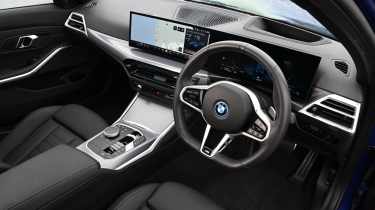
| Pros |
|
| Cons |
|
The 3 Series Touring is a subtle-looking model that arguably doesn’t turn as many heads as rivals such as the Mercedes C-Class Estate or even the Volvo V60. Sharp lines and the familiar kidney grilles up front have been a staple of the 3 Series for its entire 50-year history, while the Touring adds roof rails and a longer rear end with a tailgate that’s slightly raked, but not so much as to restrict boot space. The well proportioned and neatly finished Touring is a handsome, classy-looking machine that is, to our eyes, more attractive than the standard four-door saloon.
While this latest 3 Series Touring is noticeably more practical than earlier generations, the larger luggage area hasn’t affected the car’s ‘lifestyle’ image. That said, some of the kerbside appeal of Sport models is lost thanks to small 17-inch alloy wheels, although ironically the smaller wheels give the 3 Series chassis the most agile and engaging handling.
Buyers looking for more visual aggression will migrate towards the M Sport model, which gets a subtle bodykit, 18-inch alloys and various other cosmetic changes. Both trims can be upgraded with larger wheels, as well as some high-grade paint finishes, such as BMW’s Frozen Tanzanite Blue, although this option costs more than £4,000.
Interior and dashboard design
Inside, the Touring looks and feels identical to the saloon model. That means you get a logically laid-out dashboard, which is angled towards the driver, plus plenty of high-grade materials and impeccable fit and finish. The layout has been refreshed with new joystick-style levers to move the air vents, but the excellent iDrive controller has been retained, as has the comfortable, low-set driving position.
Materials and build quality
There are plenty of premium materials throughout the cabin, with metal trim on the dashboard and doors giving the cabin a lift, while the plastics have a soft feel to complement the leather and artificial hides that are used for the seats and steering wheel.
Infotainment, sat-nav and stereo
We’re glad that BMW hasn’t ditched the iDrive controller in the 3 Series, because it really makes a difference as to how easy it is to select functions when compared with using a touchscreen. The large circular control wheel is simple to grab and either rotate or move through four axes, while the shortcut buttons that flank the wheel also help with navigating the BMW’s menu system.
While the iDrive controller is user-friendly, the 3 Series also has a responsive touchscreen. The large 14.9-inch display has super-sharp graphics and smooth animations, while the widescreen layout has an enhanced letterbox look courtesy of the climate controls that are a permanent fixture across the bottom of the display.
The BMW’s home screen is split into three, while all of the car’s apps can be shown on a single page to scroll through. This can be made easier by selecting specific sets of functions, such as media or vehicle settings, for example.
"The 3 Series really does offer the best of all worlds when it comes to its user interface. The touchscreen is a piece of cake to use when you’re parked, while the iDrive controller and shortcut keys are handy if you need to make quick adjustments when you’re on the move." - Dean Gibson, senior test editor.
Boot space & practicality
Pros |
Cons |
|
|
The driving position and front passenger space in the Touring are naturally identical to that of other 3 Series models, which means it’s easy to get comfortable. The seats and steering wheel have masses of adjustment, and although the driving position is low-ish, that only adds to the sporty feel.
The estate car body makes up for some of the practicality that has been lost with the introduction of the 330e to the Touring line-up, although the compromises aren’t as large as they are for some of the BMW’s rivals.
| Dimensions | |
| Length | 4,713mm |
| Width | 1,827mm |
| Height | 1,448mm |
| Number of seats | Five |
| Boot space |
500-1,510 litres (330e: 410-1,420 litres) |
Dimensions and size
The 3 Series Touring has two very obvious rivals in the Mercedes C-Class Estate and recently renamed Audi A5 Avant. The BMW has the most luggage space, but sits in between the two rivals at 4,709mm in length – the A5 is 4,829mm and the C-Class 4,702mm. The trio are very similar in terms of width, and not far apart on roof height either.
Driving position, seats & space in the front
A driver-focused cockpit is typical of BMW’s cabin layout, while the 3 Series Touring has an identical set-up to the saloon. That means a relatively low-slung driving position for a sporty feel, while it also means that headroom isn’t an issue. A wide range of wheel and seat adjustment is offered, so it’s easy to get comfortable on board.
Storage is good, with twin cup-holders, a USB-A socket and 12-volt connection under the aluminium-finished panel ahead of the iDrive controller, while the armrest hides another compartment with a USB-C socket. The door bins are reasonable, but there’s a divider between the cup-holder and main pocket, so storing longer items can be fiddly.
Seats & space in the back
If you tick the option to add the £1,425 panoramic sunroof, you’re not going to compromise rear headroom as a result. There’s plenty of space for shoulders when travelling three-up, too, while legroom and foot space are decent. The only issue is middle-seat leg space, because the transmission tunnel is quite wide. The rear door bins are only big enough for bottles, while passengers also benefit from twin USB-C sockets and air vents with their own climate control settings.
There are Isofix mounting points for a pair of child seats, which you can access quite easily as the doors are reasonably sized.
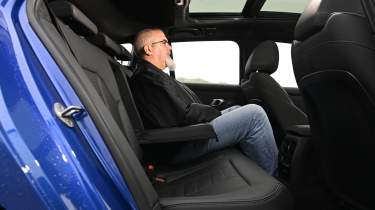
Boot space
Compact executive estates aren’t designed for maximum carrying capacity, but the BMW 3 Series Touring performs well. The 500-litre boot is 24 litres bigger than the Audi A5 Avant’s (which has a smaller boot than the Audi A4 Avant that it replaced) and 40 litres bigger than the Mercedes C-Class Estate's.
All cars come with a powered bootlid with separate opening tailgate glass as standard. Because the BMW comes with run-flat tyres, the space that would be taken up by the spare can be liberated to create a deep hidden compartment beneath the hinged boot floor.
The 330e has a cargo capacity of 410 litres, which is down to the need to fit the hybrid running gear. However, that is less of a compromise than is found in rivals such as the Mercedes C 300 e Estate, which has a far smaller boot than the petrol or diesel versions.
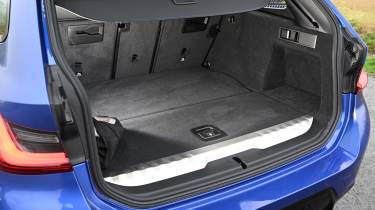
On all 3 Series Touring models the tailgate opens to reveal a wide, flat floor with a low load lip, although the hinges for the rear door encroach on the top of the opening. This means it’s tricky to make maximum use of the space if you’re trying to load something large.
The floor area is square, while the seat backs fold via levers on their shoulders in a 40:20:40 split for added flexibility. When they’re down, the sides of the cargo area are flat, and the seat backs have a slight rise in them that helps with unloading longer items. There isn’t enough room under the floor to store a charging cable, so it has to stay in the main boot or in one of the footwells, although there is space for it to be tucked behind one of the wheelarches.
Other useful items in the boot include lashing hooks in the floor, bag hooks, a folding floor divider, and a cargo net, plus extra hooks so you can separate the boot from the interior with a cargo net, whether in five-seat or two-seat modes.
Towing
Estates are popular as tow cars, and BMW offers an electrically operated towbar for the 3 Series as a £1,000 option. Fitting the towbar also upgrades the electronic stability control with a trailer stability function.
Towing weights are acceptable, if not outstanding for the 3 Series. Since there are no diesels, the best performer is the petrol M340i, with its torquey in-line six capable of hauling 1,800kg. Next up is the 320i Touring, which can tow 1,600kg. The least suited to towing is the 330e PHEV, with a maximum braked towing weight of 1,500kg – although it’s worth noting that the M3 Touring isn’t rated to tow anything at all.
"As with the whole 3 Series line-up, there’s an £1,800 premium for the 330e Touring when compared with the four-door saloon, but we think that’s a pretty reasonable price to pay. You get the extra space of the estate car boot, which offsets the additional room that’s taken up by the PHEV powertrain." - Dean Gibson, senior test editor.
Reliability & safety
| Pros |
|
| Cons |
|
There’s a raft of safety kit on board, although some of the most advanced features are only offered within pricey option packs. As standard, the 3 Series has a five-star Euro NCAP rating, but this was recorded in 2019 and the test has become more stringent over time, so it can’t really be compared with newer rivals. Plus there’s also a six-year time limit for how long a test score is valid for.
For around £800, the Driving Assistant package adds lane-keep assist, front and rear collision prevention and speed-limit assist, while the £1,250 Driving Assistant Professional also adds active cruise control (although this can be added separately for £600), automatic speed-limit assist, wrong-way warning, active side-collision protection and crossroads warning. All of these systems work smoothly and without much fuss, plus you can set the systems up as you please via the Driving Experience Control system.
| Key standard safety features |
|
| Euro NCAP safety ratings |
|
BMW’s warranty covers the car for three years, and as with its premium rivals, there’s no mileage limit to go with it. Roadside assistance lasts for the same amount of time.
One aspect of BMW ownership that’s well catered for is the after-sales package. There’s a five-year Service Inclusive option available for the 330e for just over £1,000, which covers all maintenance costs. Intervals are condition-based, so the car will let you know when maintenance is needed, although it’s likely to be every 12 months if you do a low annual mileage.
Buying and owning
Our best buy: BMW 3 Series Touring 330e M Sport
The plug-in hybrid 330e offers a good mix of power and economy. It’s a no-brainer for company car buyers, although if you can’t charge the drive battery regularly, it’s possible that the 320i will be a more economical option overall. Or you could just blow the budget and upgrade to the six-cylinder M340i instead, or even the M3 Touring if you’re feeling flush.
BMW 3 Series Touring Alternatives
The most obvious rival to the BMW 3 Series Touring is the Mercedes C-Class Estate. It comes in petrol, PHEV and high-performance guises like the 3 Series, plus it also has diesel options. Prices are higher across the board, though, and while the C-Class is an upmarket machine, it’s not quite as roomy inside as the 3 Series.
Another option is the Audi A5 Avant. Like the Mercedes, it’s not as practical as the 3 Series, but it has plenty of premium materials inside, and comes in petrol, PHEV and diesel forms, while the S5 Avant is the current flagship before an RS 5 Avant arrives at a later date.
Elsewhere, there aren’t many other estate car options. The Volvo V60 was off sale and then back on price lists, but it’s not as roomy as the 3 Series and has a limited model line-up, while the only other alternative worth considering is the Volkswagen Passat, now that the Volkswagen Arteon has gone off sale. Beyond that, you’re looking at premium SUVs, such as the BMW X3, Mercedes GLC, Porsche Macan, Lexus NX and Audi Q5.
Frequently Asked Questions
We’re definitely fans of the 3 Series Touring. We like the mix of performance, driver involvement, everyday practicality and low running costs that it offers. It’s a bit of a shame that diesel models are no longer offered, but the engine line-up still offers some variety for buyers.
Deals on the 3 Series and alternatives
Mercedes-Benz C Class

